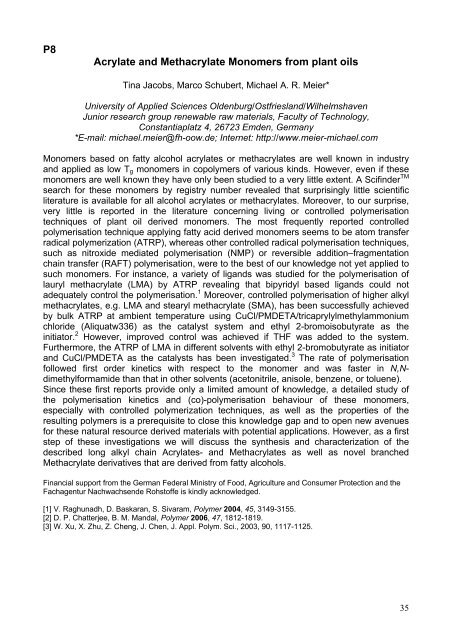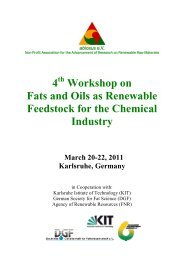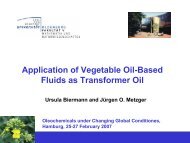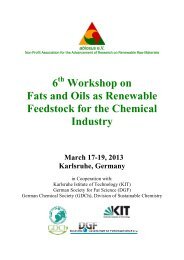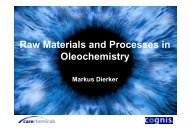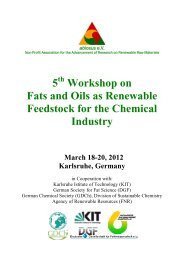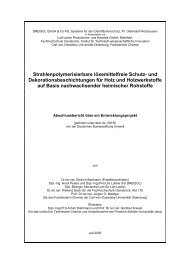Fats and Oils as Renewable Feedstock for the Chemical ... - abiosus
Fats and Oils as Renewable Feedstock for the Chemical ... - abiosus
Fats and Oils as Renewable Feedstock for the Chemical ... - abiosus
Create successful ePaper yourself
Turn your PDF publications into a flip-book with our unique Google optimized e-Paper software.
P8Acrylate <strong>and</strong> Methacrylate Monomers from plant oilsTina Jacobs, Marco Schubert, Michael A. R. Meier*University of Applied Sciences Oldenburg/Ostfriesl<strong>and</strong>/WilhelmshavenJunior research group renewable raw materials, Faculty of Technology,Constantiaplatz 4, 26723 Emden, Germany*E-mail: michael.meier@fh-oow.de; Internet: http://www.meier-michael.comMonomers b<strong>as</strong>ed on fatty alcohol acrylates or methacrylates are well known in industry<strong>and</strong> applied <strong>as</strong> low T g monomers in copolymers of various kinds. However, even if <strong>the</strong>semonomers are well known <strong>the</strong>y have only been studied to a very little extent. A Scifinder TMsearch <strong>for</strong> <strong>the</strong>se monomers by registry number revealed that surprisingly little scientificliterature is available <strong>for</strong> all alcohol acrylates or methacrylates. Moreover, to our surprise,very little is reported in <strong>the</strong> literature concerning living or controlled polymerisationtechniques of plant oil derived monomers. The most frequently reported controlledpolymerisation technique applying fatty acid derived monomers seems to be atom transferradical polymerization (ATRP), where<strong>as</strong> o<strong>the</strong>r controlled radical polymerisation techniques,such <strong>as</strong> nitroxide mediated polymerisation (NMP) or reversible addition–fragmentationchain transfer (RAFT) polymerisation, were to <strong>the</strong> best of our knowledge not yet applied tosuch monomers. For instance, a variety of lig<strong>and</strong>s w<strong>as</strong> studied <strong>for</strong> <strong>the</strong> polymerisation oflauryl methacrylate (LMA) by ATRP revealing that bipyridyl b<strong>as</strong>ed lig<strong>and</strong>s could notadequately control <strong>the</strong> polymerisation. 1 Moreover, controlled polymerisation of higher alkylmethacrylates, e.g. LMA <strong>and</strong> stearyl methacrylate (SMA), h<strong>as</strong> been successfully achievedby bulk ATRP at ambient temperature using CuCl/PMDETA/tricaprylylmethylammoniumchloride (Aliquatw336) <strong>as</strong> <strong>the</strong> catalyst system <strong>and</strong> ethyl 2-bromoisobutyrate <strong>as</strong> <strong>the</strong>initiator. 2 However, improved control w<strong>as</strong> achieved if THF w<strong>as</strong> added to <strong>the</strong> system.Fur<strong>the</strong>rmore, <strong>the</strong> ATRP of LMA in different solvents with ethyl 2-bromobutyrate <strong>as</strong> initiator<strong>and</strong> CuCl/PMDETA <strong>as</strong> <strong>the</strong> catalysts h<strong>as</strong> been investigated. 3 The rate of polymerisationfollowed first order kinetics with respect to <strong>the</strong> monomer <strong>and</strong> w<strong>as</strong> f<strong>as</strong>ter in N,Ndimethyl<strong>for</strong>mamidethan that in o<strong>the</strong>r solvents (acetonitrile, anisole, benzene, or toluene).Since <strong>the</strong>se first reports provide only a limited amount of knowledge, a detailed study of<strong>the</strong> polymerisation kinetics <strong>and</strong> (co)-polymerisation behaviour of <strong>the</strong>se monomers,especially with controlled polymerization techniques, <strong>as</strong> well <strong>as</strong> <strong>the</strong> properties of <strong>the</strong>resulting polymers is a prerequisite to close this knowledge gap <strong>and</strong> to open new avenues<strong>for</strong> <strong>the</strong>se natural resource derived materials with potential applications. However, <strong>as</strong> a firststep of <strong>the</strong>se investigations we will discuss <strong>the</strong> syn<strong>the</strong>sis <strong>and</strong> characterization of <strong>the</strong>described long alkyl chain Acrylates- <strong>and</strong> Methacrylates <strong>as</strong> well <strong>as</strong> novel branchedMethacrylate derivatives that are derived from fatty alcohols.Financial support from <strong>the</strong> German Federal Ministry of Food, Agriculture <strong>and</strong> Consumer Protection <strong>and</strong> <strong>the</strong>Fachagentur Nachwachsende Rohstoffe is kindly acknowledged.[1] V. Raghunadh, D. B<strong>as</strong>karan, S. Sivaram, Polymer 2004, 45, 3149-3155.[2] D. P. Chatterjee, B. M. M<strong>and</strong>al, Polymer 2006, 47, 1812-1819.[3] W. Xu, X. Zhu, Z. Cheng, J. Chen, J. Appl. Polym. Sci., 2003, 90, 1117-1125.35


